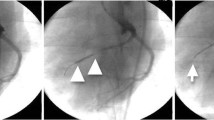Abstract
Measurements of infarct size by use of tripenyltetrazoliumchloride (TTC) is a widely accepted method used to delineate the extent of myocardial necrosis following coronary occlusion and reperfusion in various animal experiments. There is controversy, however, regarding the optimal reperfusion time for estimating the maximally infarcted area by TTC staining in the rat. We tested six different reperfusion times following 90 minutes of regional myocardial ischemia. Group 1 had 5 minutes of reperfusion (n=6), group 2 had 30 minutes of reperfusion (n=6), group 3 had 1 hour of reperfusion (n=6), group 4 had 2 hours of reperfusion (n=6), group 5 had 3 hours of reperfusion (n=6), group 6 had 4.5 hours of reperfusion (n=6). Risk areas, measured by the use of blue dye, were similar among the 6 study groups. Infarct size as a percent of risk area was 57±11% in group 1, 74±7% in group 2, 61±9% in group 3, 71±5% in group 4, 70±5% in group 5, and 64±9% in group 6 (x±standard error [SE]). There was no signifcant difference in infarct size between the groups. However, prior to 60 minutes of reperfusion, patches of pink and white areas were observed within the risk regions, indicating a more difficult assessment of proper delineation of outer regions of necrotic tissue. For acute assessment of infarct size, reperfusion for 60 minutes or more is optimal because the infarct does appear homogeneous at that time and does not become larger with longer reperfusion periods.
Similar content being viewed by others
References
Sandritter W, Jestädt R. Triphenyl-tetrazolium (TTC) als Reduktionsindikator zur makroskopischen Diagnose des frischen Herzinfarktes. Verh Dtsch Ges Pathol 1958;41:165-170.
Jestädt R, Sandritter W. Erfahrungen mit der TTC (Triphenylterazoliumchlorid) Reaktion für r die pathologischanatomische Diagnose des frischen Herzinfarktes. Z Kreislaufforsch 1959;48:802-809.
Klein HH, Puschmann S, Schaper J, Schaper W. The mechanism of the tetrazolium reaction in identifying experimental myocardial infarction. Virchows Arch 1981;393:287-297.
Goto M, Tsuchida A, Liu Y, Cohen MV, Downey JM. Transient inhibition of glucose uptake mimics ischemic preconditioning by salvaging ischemic myocardium in the rabbit heart. J Mol Cell Cardiol 1995;27:1883-1894.
Hale SL, Hammerman H, Kloner RA. Effect of two per¯uorocarbon emulsions on reperfusion injury after coronary artery occlusion in rabbits. Basic Res Cardiol 1995;90:404-409.
Liu GS, Jacobson KA, Downey JM. An irreversible A1-selective adenosine agonist preconditions rabbit heart. Can J Cardiol 1996;12:517-521.
Ytrehus K, Walsh RS, Richards SC, Downey JM. Hydrogen peroxide as a protective agent during reperfusion. A study in the isolated perfused rabbit heart subjected to regional ischemia. Cardiovasc Res 1995;30:1033-1037.
Noble MI, Belcher PR, Drake-Holland AJ. Limitation of infarct size by trimetazidine in the rabbit. Am J Cardiol 1995;76:41B-44B.
Klein HH, Pich S, Bohle RM, Wollenweber J, Nebendahl K. Myocardial protection by Na(+)-H+ exchange inhibition in ischemic, reperfused porcine hearts. Circulation 1995;92:912-917.
Klein HH, Pich S, Lindert S, Heimberg S, Maisch B, Nebendahl K. Effects of R56865, an Na(+)-and Ca(2+)-overload inhibitor, on myocardial injury in ischemic, reperfused porcine hearts. J Cardiovasc Pharmacol 1995;25:163-167.
Heller LI, Villegas BJ, Weiner BH, McSherry BA, Dahlberg ST, Leppo JA. Use of sequential teboroxime imaging for the detection of coronary artery occlusion and reperfusion in ischemic and infarcted myocardium. Am Heart J 1994;127:779-785.
Hohlfeld T, Braun M, Strobach H, Schrör K. Protection of reperfused ischemic pig myocardium by nexopamil, a new combined Ca2+ and serotonin antagonist. J Cardiovasc Pharmacol 1994;23:922-931.
Rohmann S, Weygandt H, Minck KO. Preischaemic as well as postischaemic application of a Na+/H+ exchange inhibitor reduces infarct size in pigs. Cardiovasc Res 1995;30:945-951.
Sack S, Mohri M, Arras M, Schwarz ER, Schaper W. Ischaemic preconditioning-time course of renewal in the pig. Cardiovasc Res 1993;27:551-555.
Van Winkle DM, Chien GL, Wolff RA, Soifer BE, Kuzume K, Davis RF. Cardioprotection provided by adenosine receptor activation is abolished by blockade of the KATP channel. Am J Physiol 1994;266:H829-839.
Vivaldi MT, Kloner RA, Schoen FJ. Triphenyltetrazolium staining of irreversible ischemic injury following coronary artery occlusion in rats. Am J Pathol 1985;121:522-530.
National Research Council. Guide for the Care and Use of Laboratory Animals. Washington, DC: author, 1996.
Birnbaum Y, Hale SH, Kloner RA. Differences in reperfusion length following 30 minutes of ischemia in the rabbit influences infarct size, as measured by triphenyltetrazolium chloride staining. J Mol Cell Cardiol 1997;29:657-666.
Richard V, Kaeffer N, Hogie M, Tron C, Blanc T, Thuillez C. Role of endogenous endothelin in myocardial and coronary endothelial injury after ischaemia and reperfusion in rats: studies with bosentan, a mixed ETA-ETB antagonist. Br J Pharmacol 1994;113:869-876.
Lee JY, Warner RB, Adler AL, Opgenorth TJ. Endothelin ETA receptor antagonist reduces myocardial infarction induced by coronary artery occlusion and reperfusion in the rat. Pharmacology 1994;49: 319-324.
Liu Y, Downey JM. Ischemic preconditioning protects against infarction in rat heart. Am J Physiol 1992;263:H1107-H1112.
Liu Y, Downey JM. Preconditioning against infarction in the rat heart does not involve a pertussis toxin sensitive G protein. Cardiovasc Res 1993;27: 608-611.
Yellon DM, Alkhulaifi AM, Browne EE, Pugsley WB. Ischaemic preconditioning limits infarct size in the rat heart. Cardiovasc Res 1992;26: 983-987.
Li Y, Kloner RA. Cardioprotective effects of ischaemic preconditioning are not mediated by prostanoids. Cardiovasc Res 1992;26:226-231.
Lee YM, Sheu JR, Yen MH. BN-063, a newly synthesized adenosine A1 receptor agonist, attenuates myocardial reperfusion injury in rats. Eur J Pharmacol 1995;279:251-256.
Author information
Authors and Affiliations
Rights and permissions
About this article
Cite this article
Schwarz, E.R., Somoano, Y., Hale, S.L. et al. What is the Required Reperfusion Period for Assessment of Myocardial Infarct Size Using Triphenyltetrazolium Chloride Staining in the Rat?. J Thromb Thrombolysis 10, 181–187 (2000). https://doi.org/10.1023/A:1018770711705
Issue Date:
DOI: https://doi.org/10.1023/A:1018770711705




